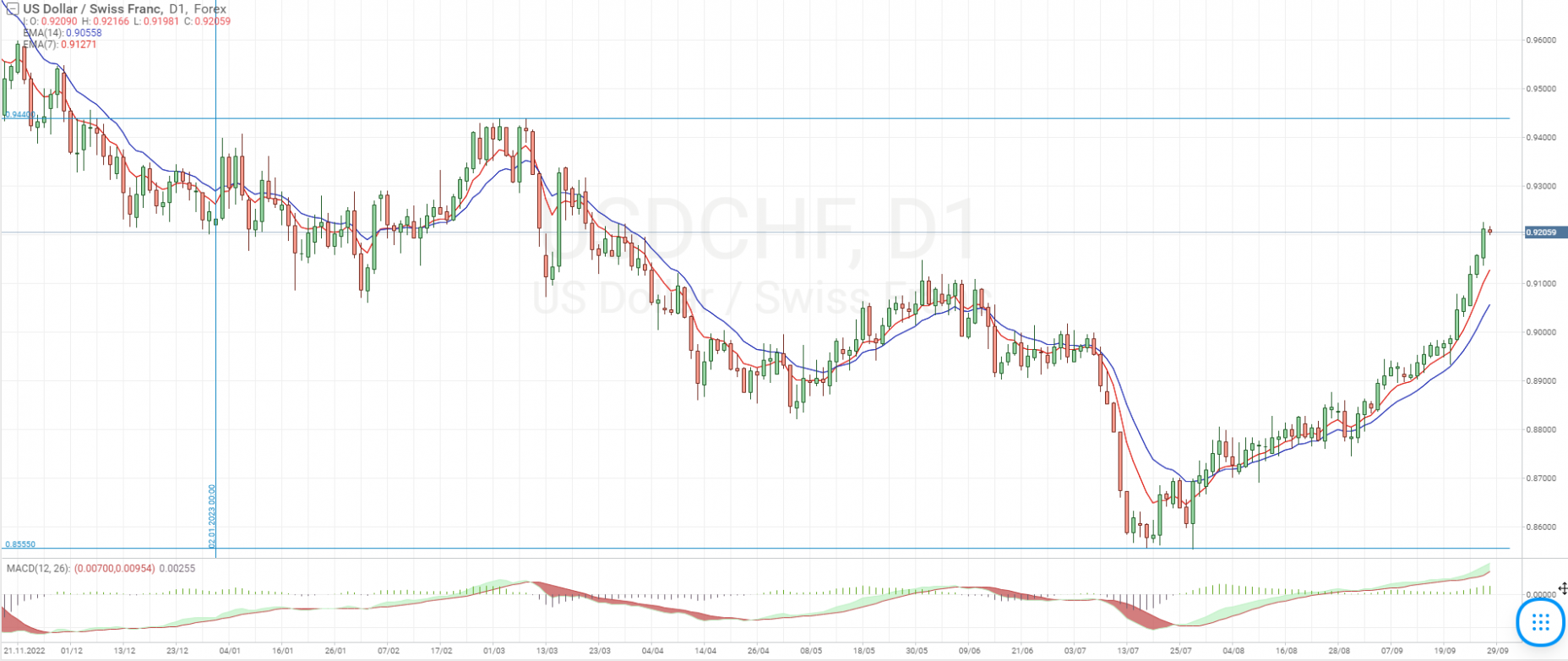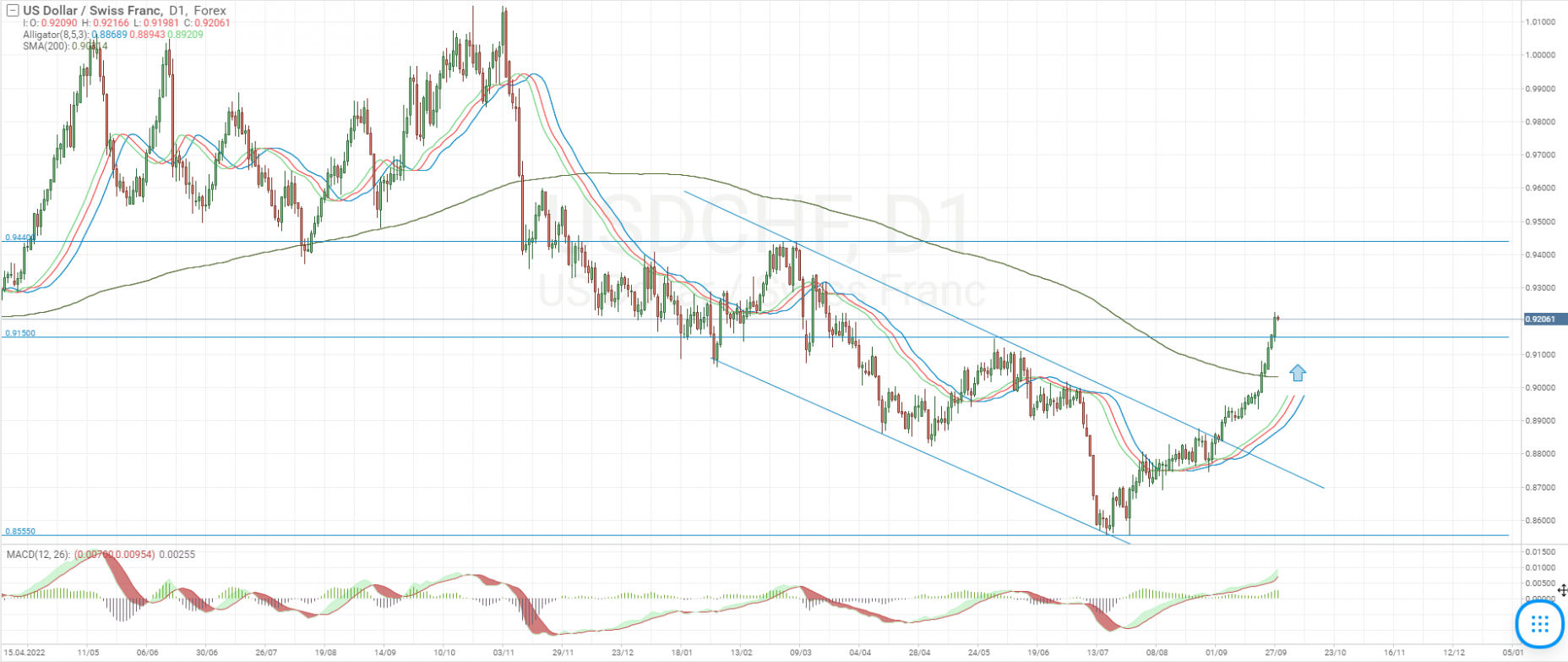USD/CHF Forecast: Will the Swiss Franc Rise in 2023?

7 minutes for reading
USD/CHF is one of the major currency pairs in the international foreign exchange market. In this article, we will examine the key factors affecting the pair’s exchange rate, analyse the USD/CHF performance in 2023, and explore the short-term and medium-term forecasts provided by experts.
You can visit the RoboForex Market Analysis webpage for the latest USD/CHF forecasts.
Overview of the USD/CHF currency pair
USD/CHF shows the ratio of the US dollar (USD) to the Swiss franc (CHF). Its quotes indicate how many Swiss francs need to be paid for one US dollar. When the exchange rate of the pair rises, this means that the US dollar is strengthening against Switzerland’s currency. When the exchange rate drops, this signals that the CHF is on the rise against the US dollar.
Trading characteristics of the USD/CHF pair
- Trading hours – The USD/CHF pair is traded round the clock from Monday to Friday, with the highest trading volumes observed during the European and American trading sessions when key economic indicators are released, potentially impacting the pair's exchange rate and leading to significant movements for USD/CHF
- Volatility – USD/CHF is a moderately volatile pair, characterised by average daily fluctuations ranging from 500 to 800 pips. However, during times of crises and stock market declines, the pair can experience substantial movements exceeding 1,500 pips per day
- Spread – As one of the major currency pairs, USD/CHF benefits from high liquidity and moderate volatility, resulting in minimal spreads. In popular ECN accounts, spreads commonly remain below 10 pips
Fundamental factors influencing the USD/CHF quotes
The Swiss central bank’s monetary policy
The Swiss National Bank (SNB) has been tightening its monetary policy since 2022 to combat inflation. During the tightening cycle, the Swiss central bank raised the key rate by 250 basis points from -0.75% in March 2022 to 1.75% in June 2023. At the last meeting on 21 September, the rate remained unchanged at 1.75% despite expectations of another hike to 2%.
The SNB’s decision to leave the interest rate at the same level shows that the central bank does not see strong reasons for further increases, and the pause may extend. Some analysts note that the SNB has every reason to gradually end the tightening cycle given low inflation in the country, a strong franc, and slowing economic activity in Switzerland and the world.
The Federal Reserve’s monetary policy
The US Federal Reserve is also looking to bring down mounting inflation by tightening monetary policies. Since the beginning of 2022, the interest rate has gradually risen from 0.25% to 5.5%, significantly affecting the exchange rate of the US dollar, which had strengthened against a number of world currencies over this period.
On 20 September 2023, the Fed left the interest rate unchanged at 5.5%. The central bank of the US noted that economic activity continues to grow steadily, and although job gains have slowed, it is still impressive. The Fed’s chair emphasised that the inflation rate remains high with inflation risks being the focus of attention. Analysts predict that the US will see one more interest rate hike by the end of 2023.
CHF’s function as a safe-haven currency during crises
Throughout its history, the Swiss franc has often been regarded as a safe-haven currency. Historically, the franc had almost no inflation, and the Swiss legislation also provided for mandatory gold and foreign currency reserves. This requirement was abolished in 2000 due to amendments to the Swiss constitution.
Due to Switzerland's flexible exchange rate and stable economic development, the Swiss franc is considered one of the world's most stable currencies, making it highly desirable as a reserve currency. During times of crisis, the Swiss franc is frequently sought after as a safe-haven asset, which can contribute to its appreciation against other global currencies.
Economic development indicators of the US and Switzerland
- Unemployment Rate
- Nonfarm Payrolls
- GDP Growth Rates (GDP)
- Inflation Indices (CPI, PPI)
- Industrial Production (Industrial Production Index)
- Retail Sales
- Trade Balance
- Consumer Confidence Index
- ISM Manufacturing Purchasing Managers Index
USD/CHF performance in 2023
The USD/CHF pair shows mixed trends in 2023, trading within a wide sideways range. In March 2023, the upper boundary of this range was set at the 0.9440 mark while the lower formed in July at 0.8555. At the time of writing, USD/CHF quotes are experiencing a robust upward momentum on the daily chart, hovering at approximately 0.9200, the same level as at the beginning of 2023.

USD/CHF live chart
USD/CHF technical analysis
After reaching an annual low of 0.8555 in July, the USD/CHF currency pair reversed upwards on the daily chart, showing strong upward momentum. It broke the upper boundary of the descending price channel, and confidently secured above the 200-day Moving Average, signalling a reversal of the previous downtrend.
There is a strong uptrend now, which might lead to a revisit of the annual high of 0.9440. Explosive growth could soon be followed by a downward correction, after which the pair is likely to continue its upward movement. The nearest support level is the 0.9150 mark, with a more significant support area located at 0.9000, near the 200-day SMA.

USD/CHF forecasts for 2023
- Analysts at Credit Suisse expect USD/CHF quotes to reach 0.9500 by the end of 2023
- Citibank’s specialists suggest the pair will hover around 0.9200 by the end of 2023 and the beginning of 2024
- UBS economists raised their forecast of the pair’s exchange rate to 0.9200 (from 0.8700) by the end of the year
Long-Term USD/CHF forecasts
- HSBC experts presume that the US dollar is currently overvalued and will revert to fair value within five years as US yields decline and equity markets gain. They expect the USD/CHF exchange rate to stand at 0.9200 by mid-2024 and fall further to 0.9000 by 2026
- Analysts at the Economy Forecast Agency (EFA) predict that the USD/CHF exchange rate will be 0.8840 by the end of 2024, 0.8910 by the end of 2025, and 0.8710 by the end of 2026
- According to the Wallet Investor portal, USD/CHF will reach 0.9058 by the end of 2024 and 0.9010 by the end of 2025
Summary
In early 2023, the USD/CHF currency pair demonstrated downward momentum due to the Swiss National Bank's rising interest rates. July marked a turning point, after which the pair reversed upwards, showing a strong uptrend. A key reason for franc’s depreciation is that the Swiss National Bank ended its interest rate hike cycle amid an environment of weak economic data and slowing inflation in the country. In contrast, the US Federal Reserve is poised to continue tightening its monetary policy.
FAQ
Why is USD/CHF forecasting important?
Forecasting is crucial for strategic planning and risk management, helping investors predict movements of the currency pair.
What methods are used to forecast USD/CHF?
Commonly employed methods include fundamental analysis, technical analysis, and sentiment analysis.
How accurate are USD/CHF forecasts?
While forecasting methods have their advantages, they are not entirely dependable. A wide range of factors can affect USD/CHF and trigger unexpected price movements.
What are the risks in USD/CHF forecasting?
The primary risk lies in the unpredictability of global political and economic events that can significantly affect the USD/CHF rate.
What potential future events could trigger changes in the USD/CHF exchange rate?
The list of potential events is extensive, including shifts in the monetary policies of US and Swiss regulators, considerable fluctuations in resource prices, geopolitical changes, natural and human-caused disasters, as well as crisis developments in national and global economies.
Will the USD/CHF exchange rate continue to remain volatile?
Influenced by various factors, the USD/CHF rate may maintain its volatility.
How does the difference in interest rates affect the USD/CHF rate?
An increasing interest rate in the US contributes to the pair’s upward movement, whereas an interest rate hike in Switzerland exerts downward pressure on the USD/CHF quotes.













